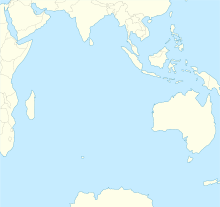Sunda Trench
Coordinates: 10 ° 19 ′ 0 ″ S , 109 ° 58 ′ 0 ″ E

The Sunda Trench , also Java trench called, is one to 7290 m deep and 2250 km long Tiefseerinne before the Sunda arc in the northeast of the Indian Ocean , where is the lowest point of that ocean.
geography
The Sunda Trench is located south of the Asian Sunda Islands between Sumatra in the northwest, Java in the north, including Lombok , Sumbawa and Sumba in the northeast, the Timor Sea in the east, the North Australian Basin in the southeast, the Northwest Australian Basin and the Christmas Island in the south and southwest and the Keeling basin in the west.
The elongated Sunda Trench , which was created (or continues to develop) as a result of the subduction of the Australian plate under the Eurasian plate , lies between about 5 and 12 ° south latitude and 100 and 120 ° east longitude .
In 2019, an expedition attempted to reach the deepest points of all oceans and mapped the area using a lander and a fan sonar . Victor Vescovo reached in its submersible Limiting Factor a depth of about 7192 m at 11 ° 7 '44 " S , 114 ° 56' 30" O . The Diamantina Deep, which was previously the deepest point at over 8000 m, could not be found; the deepest point of the Diamantina Fracture Zone is around 7100 m in the Dordrecht Deep . Since then, the Sunda Trench has been considered the deepest point in the Indian Ocean.
Based on bathymetric calculations, depths between 7204 m and 7318 m were given, so that the exact depth and location of the deepest point can still be considered controversial. Stewart and Jamieson state in 2019, based on the best-resolving data sets, a 7,290 m deep sea low ( 11 ° 12 ′ 0 ″ S , 118 ° 28 ′ 12 ″ E ) as the likely lowest point.
See also
Individual evidence
- ↑ FAQ , fivedeeps.com, accessed May 12, 2020.
- ↑ Ben Taub, Paolo Pellegrin: Thirty-six Thousand Feet Under the Sea: The explorers who set one of the last meaningful records on earth . In: The New Yorker , May 10, 2020.
- ↑ Heather Stewart, Alan Jamieson, Cassie Bongiovanni: Exploring the Deepest Points on Planet Earth: Report on The Five Deeps Expedition . www.hydro-international.com, June 18, 2019.
- ↑ Heather A Stewart, Alan J. Jamieson: Habitat heterogeneity of hadal trenches: Considerations and implications for future studies . In: Progress in Oceanography 161, February 2018, pp. 47-65, doi: 10.1016 / j.pocean.2018.01.007 .
- ^ PT Harris, M. Macmillan-Lawler, J. Rupp, EK Baker: Geomorphology of the oceans . In: Marine Geology 352, June 2014, pp. 4–24, doi: 10.1016 / j.margeo.2014.01.011 .
- ↑ Heather A. Stewart, Alan J. Jamieson: The five deeps: The location and depth of the deepest place in each of the world's oceans . In: Earth-Science Reviews 197, October 2019, 102896, doi: 10.1016 / j.earscirev.2019.102896 .
